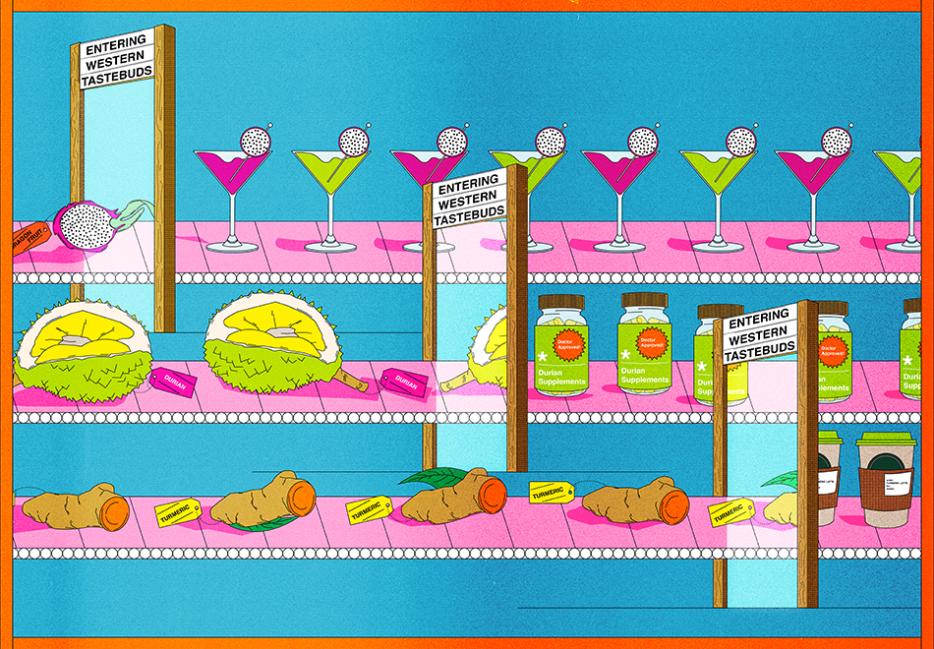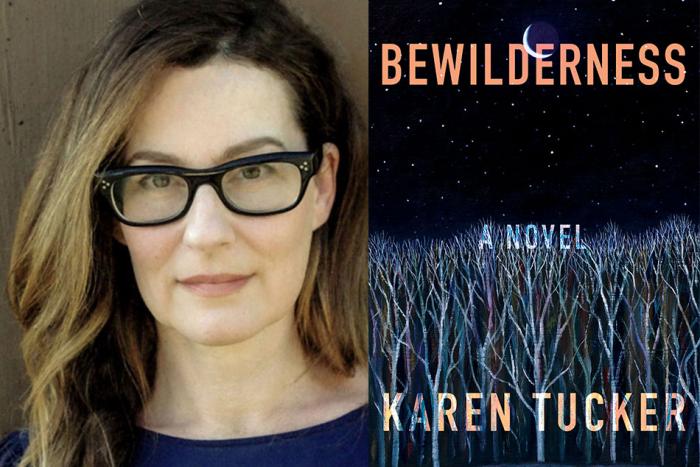In June 2020, writer and historian Soon-Tzu Speechley tweeted a criticism of the typical food writing published in The New York Times. “Writing about US food the way the NYT covers Asian fruit,” Speechley wrote: “In a nation torn by racial conflict, one unlikely food unites. To those accustomed to chopsticks, the greasy parcel known as a ‘burger,’ a sort of split bao, is crude and messy. Yet it encapsulates a nation’s violent past.” Social media users, especially those in the Global South, were delighted with Speechley’s exposure of the condescension often adopted by Western publications towards foods and cultures with origins outside North America and Western Europe.
That same month, The New York Times published a piece titled “Eating Thai Fruit Demands Serious Effort but Delivers Sublime Reward.” The piece is a dispatch from the markets of Bangkok, in which the writer, Hannah Beech, describes fruits—jackfruits, durians, rambutans—as unwelcoming and even diabolic. She calls mangosteens “an exercise in disappointment,” and durian “an infamous fruit, which stinks of death.” The piece itself reeks of confident, nonchalant bias. Often, Beech sounds like she is under attack.
It was a year when food media companies faced heightened scrutiny online. Discussions about systemic racism and the discrimination and disadvantages that non-white media professionals face in the field came to the fore. Food media giant Bon Appétit’s former editor Adam Rappaport resigned after a photo from 2004, where he posed with his wife in brownface, surfaced. The photograph set off a wave of call-outs about Bon Appétit’s toxic workplace, ill-treatment of employees of colour and overall callousness when it came to racial sensitivity. Following the upheavals at Bon Appétit, there was a promise to build better structures, especially for Black, brown, Asian and Indigenous writers, editors, and chefs in the United States.
In the middle of the reckoning, Nigerian chef and writer Tunde Wey, who lives in New Orleans, noted the alliance of the white food media in the United States with Black and brown folks at its own convenience. In a piece titled “White food media and the commodification of resistance” for Scalawag magazine, he wrote, “In a system where goodwill is eventually monetized, charity and virtue has become currency for white food media… Because what use was a politicized identity when it couldn’t be sicc’ed on something?”
***
Even when the language employed for non-Western food in Western media is favourable, it’s often paternalistic: dishes are translated as “comfort foods,” “heritage dishes” or established as the “real authentic.” As foods from different origins enter the pantries and media landscapes of the West, they are rendered in eulogizing stereotypes, meet-cutes are staged, “discoveries” are made; everyday ingredients are captured in high-definition, and these foods are often Westernized to the point of disintegration.
A boost in mainstream integration of Indian food in the American imagination synced with the established and rising power of the wealthy, dominant-caste Hindu Indian diaspora in the United States. A 2013 editorial in n+1 called South Asians the most powerful and successful immigrant minority in America. “No immigrant group in the US is so uniformly rich, so well placed in professional and executive ranks, so widely dispersed and integrated into wealthy white society.” As elite Indian immigrants succeeded to white-adjacency, Indian cuisine became a covetable culture, an assimilated brand into the American capitalist ideal.
An aesthetic was created for Indian-ness that edged on rose-tinted mysticism and nostalgia, full of buzzwords: tradition, healthy, colourful, family. A small group spoke about Indian cuisine with tones of romantic zeal and ardour, and were welcomed as proprietors of representation for South Asians, both in Western diasporas and in the subcontinent itself. Through them, carefully curated Indianisms were filtered through American sentimentalism. Suddenly, samosas were racked on fancy ceramic plates; words like Dishoom, the name for a popular Indian restaurant in London and the sound associated with a gunshot, were enveloped in bourgeois glory. Indian foods and by consequence, Indians, became cloaked in metrics of wholesomeness, there was a homogenous paradigm of sameness for Indians (and South Asians) that watered down our representation to the rest of the world.
But the production of the aesthetic has remained dissonant from its place of origin. The plain fact that every experience of food in India is embroiled in the violent and segregated system of caste is never touched upon. The elevated language employed for Indian foods and cultures glosses over the physical, economic, and social realities of the subcontinent, where under the authoritarian right-wing rule of the Narendra Modi-led BJP government, farmers rights remain curtailed; and large-scale unemployment and the COVID-19 pandemic has created more food insecurity and hunger than the years before.
This model aesthetic also spoke over the foods of India’s neighbours in Bangladesh, Pakistan, Afghanistan, Tibet, and glossed over regional foods outside the North Indian mainland. It was a bizarrely simplistic mode in which to perceive a country infinitely creviced by topography, land culture, social location, language, caste and class. The cuisines of working-class South Asians, Muslims, and Indigenous people, as well as audacious, inventive modern foods that had no connection to tradition whatsoever, never made the cut. Most grating was the celebration of Indian vegetarianism: a tool of surveillance and discrimination by dominant-caste Hindus in India on Muslims and marginalized-caste communities. In the West, the lifestyle was elevated to a cultural boon. To observe the same things that signified supremacy in India be celebrated as milestones elsewhere felt eerie.
As for myself, I did not grow up in a kitchen where meals were conducted like delicious operas. I was raised in a family of Tamils, who had for three generations lived far away from our immediate roots, first in Rawalpindi, then in Karachi, then Delhi. We ate with the agency afforded by caste, with the functionality of middle class city-dwellers. My diet and palate were bound to the market and what was considered frugal and utilitarian, I did not find much that was glorious about my family’s dining rituals. I do not possess heirloom tricks passed down from my grandmother; I spent a life, like my father and grandfather, eating whatever came my way. We were a family of middling cultures, far from what was considered traditionally accurate and celebratory. The energy that I grew up around and embodied did not find a place in glossy geometries of representation and culture as commodity. Even as Indian food made inroads in the United States, the complexities and even cruelties within it were often obscured, the various regional and sub-regional ways in which people ate and lived were discarded for more cliché, colourful claims.
***
Intimacy between food and language can light up the intricacies of a certain individual or community; there are great things possible in the way food spurs specific language to take shape. In White Trash Cooking, a spiral bound cookbook by Ernest Mickler, an American chef from the South, he writes about onions: “Cook ‘em, slice ‘em, till you can see through ‘em,” introducing a world so vivid and distinct from the otherwise shiny cultures of North America that many of us living elsewhere have imbibed since we were children. Longthroat Memoirs, a book of essays by Nigerian writer Yemisi Aribisala, succeeds in taking back language, neglecting stereotypes of “stodge,” and “soup” that Aribisala notes were often reserved for foods like hers. She writes of “puff-puffs” eaten at crowded road corners, a ram riding on a scooter that would soon be dinner, and akara, the black-eyed bean she heard stories about as a child in her native Nigeria. “The word akara is soft, seductively broken on the back of the letter k, so you can conjure up a squish and hushed chew, the compression flowing through the respiring pores of hot, freshly fried pillows of seasoned, milled beans,” Aribisala writes. “No one ever talks about the oil insidiously escaping out of the kitchen towel, oozing from the akara, direction to every self-righteous resolution of fried foods you ever made.” Aribisala’s language is laid with idioms and tonalities of the specific English of her upbringing. She mediates English with insertions of Igbo, and the foods she writes about do not pander, or make themselves small to appeal to anyone else.
In 2020, a London-based newsletter was pioneered by writer and editor Jonathan Nunn, publishing pieces with dialect-driven representation of food and language. Nunn introduced Vittles by saying: “I’ve always thought it strange that food writing—something that literally everyone in the world, no matter what class or race or religion, has an opinion on—is actually one of the least democratic forms of writing that gets regularly published.” From the get-go, Vittles has decentred the British capital, questioned American dominion, favoured regionalism, and complicated the banal reservations so often kept about the British North and working classes. Perhaps what is most notable about Vittles is its devotion to a diversity of perspectives about foods and not just food itself; and its keenness to tilt an axis of relativity in which Western foods and cultures are considered the centre, from where others branch out. Vittles does not consider one perspective, region or country primary, instead treating every perspective with the same universality afforded to the cultural centres in the United Kingdom, Europe and the United States. In one of my favourite pieces in the newsletter, Nina Mingya Powles discloses that she cannot translate dòufu huā into English, as “it loses some of its taste, its shape…The direct translation is ‘tofu flower’ and Beijingers call it dòufunǎo, ‘tofu brains.’” Mingya Powles writes. “In English you could call it ‘soft beancurd,’ or even ‘jellied tofu’ as my dictionary app suggests. ‘Tofu pudding’ is the one translation that makes sense to me, owing to its custard-like texture.” Mingya Powles does not concentrate on strip mining the item for those like me who may not know it, but with illustrations in Chinese characters, dòufu huā remains fairly unknowable yet completely visible, a full form. Perhaps what is most liberating about this kind of work is that these writers write in affirmation. They do not write in combat, but there is a victorious aloofness to fighting the Eurocentric and American-capitalist perception of non-Western foods. They write, somehow, for themselves.
***
In India, food journalism is a relatively nascent genre. It sits in the lifestyle industry, and its reins are held by elite critics and influences, who decide what a nation of a billion, splintered by social hierarchies, should eat. For me, the idea of working, instead, for the global food media was exciting. Writing for publications abroad, I thought, would allow me space to use food to think about the political and socio-economic climates of the country and continent where I lived. I aspired not to introduce what we ate to the West, but to think about the things—trade, migration, gender, and economic fluctuation—that surround the foods we consumed, the ways in which we cooked.
As the food media in the United States confronted these imbalances with varying degrees of successful accountability, I wondered what these developments would mean for writers in the global South. Would non-Western foods still be positioned as a sign of gastronomic daring or multiculturalism? In this new, reformed food media, would Indian food still be limited to an array of vegetarian mothers, Ayurveda, over-the-top giddiness at eating raw turmeric? Would writers from Karachi and Cairo still be interchangeable? When stories from countries outside North America and Western Europe were included, would they be plastic wrapped in friendly semantics for easy absorption?
But when I began to pitch to American food publications, big and small, I found myself shifting my perspective to match the one expressed in dominant publications like Bon Appétit and The New York Times food section. These Americanized perspectives influenced the way I thought and felt about food. I read the publications with feigned interest driven by misplaced aspiration, in the same way that, as teenagers with sudden access to American television, my friends and I would laugh mechanically in sync with Friends reruns even though the references and humour were out of any real reach.
Very soon, I found myself approaching things familiar to me with a fairy tale-like mysticism. When I spoke about foods I grew up with around Delhi, I began to glorify and dissect. I racked my brain for praises of dal-chawal. To write neatly digestible text, I tried to code familiar foods into adaptable Western packages for an American readership. I translated everyday things as a “kind of crepe,” or a “sort of sauce.” I believed that I had to explain, instruct, and pander to a comfortable fantasy staged in the West about the cultures of South Asia. Even though I knew it was untrue, I found myself responding to assumptions about the dispositions of Indians–docility and good-behaviour, the stereotype that governed Indian women and families—domesticity, generosity, and an affinity for nourishment and care.
In early 2021, I was coaxed into the dreary task of cultural spoon-feeding by an editor for a piece I was writing about the emergence of home kitchens during the pandemic in India. I did my job, writing lazy Wikipedia-style suffixes for each region in the subcontinent. “Make it clickable,” prodded my editor, also Indian, also jaded. “Make it simple. So they understand.” The focus of food media and writing about food remains to drive consumption.
Many of the answers to the question of how to fix food media come from within it. Wey’s critique is important, as are suggestions from writer Alicia Kennedy, who proposes that food media, like literature, should work in translation. In her newsletter, Kennedy asks, “How much more accurately would the culinary world be depicted if we let people speak in the language that allows them to say what they want, not just what they can?” In a piece written in 2020 about Alison Roman, Navneet Alang illuminates how food media’s whiteness lies in its geometry. “It is more accurate to say that the way we define what is contemporary and fashionable in food is tied to whiteness as a cultural norm—and to its ability to incorporate other cultures without actually becoming them.” Alang writes, noting how it is the spectrum that must be dismantled, instead of certain non-white cultures being brought about at whim. In his book, Taste Makers, writer Mayukh Sen questions what he calls the “food-establishment” when he profiles seven immigrant women who changed how America ate. “Capitalism can encourage artists, including chefs and cookbook authors, to suppress parts of themselves to cater to market’s desires.”
As I continue to write about food, I don’t want to buy into predisposed, inaccurate notions of British food as tasteless; Chinese food deviant, West African food heavy, and other stereotypes of soup, stodge, and spice. But I also do not want to write another shining, friendly sentence about a food like the samosa, one I know only from the street, eaten while shouting at uncles and glaring at my friends as they try to reach for my crusts in scorching Delhi heat. I cannot read another listicle glorifying dominant-caste Hindu food practices without context, when my country remains in the grip of a Hindu nationalist government, my friends arrested, and our lives torn apart.
When food writing is not done in exclusion, it lives outside the genres of glistening recipes written with over-compensating zeal. It is a solemn, celebratory narrative, a web of scene and place. If the food media can let go of their penchant for either disdain or exoticism, we may be able to create an industry that gets at the heart of what matters about cuisine and culture.






